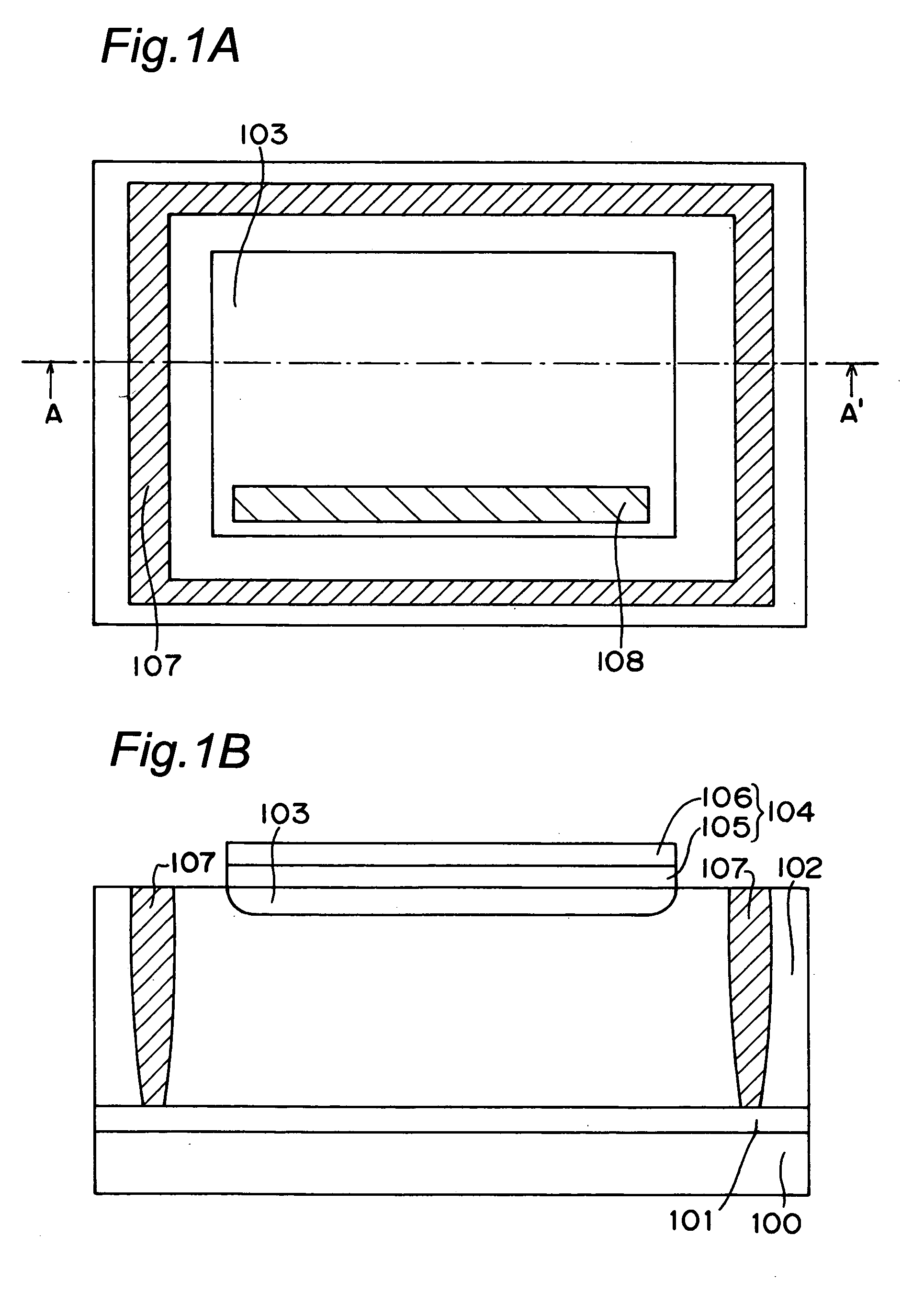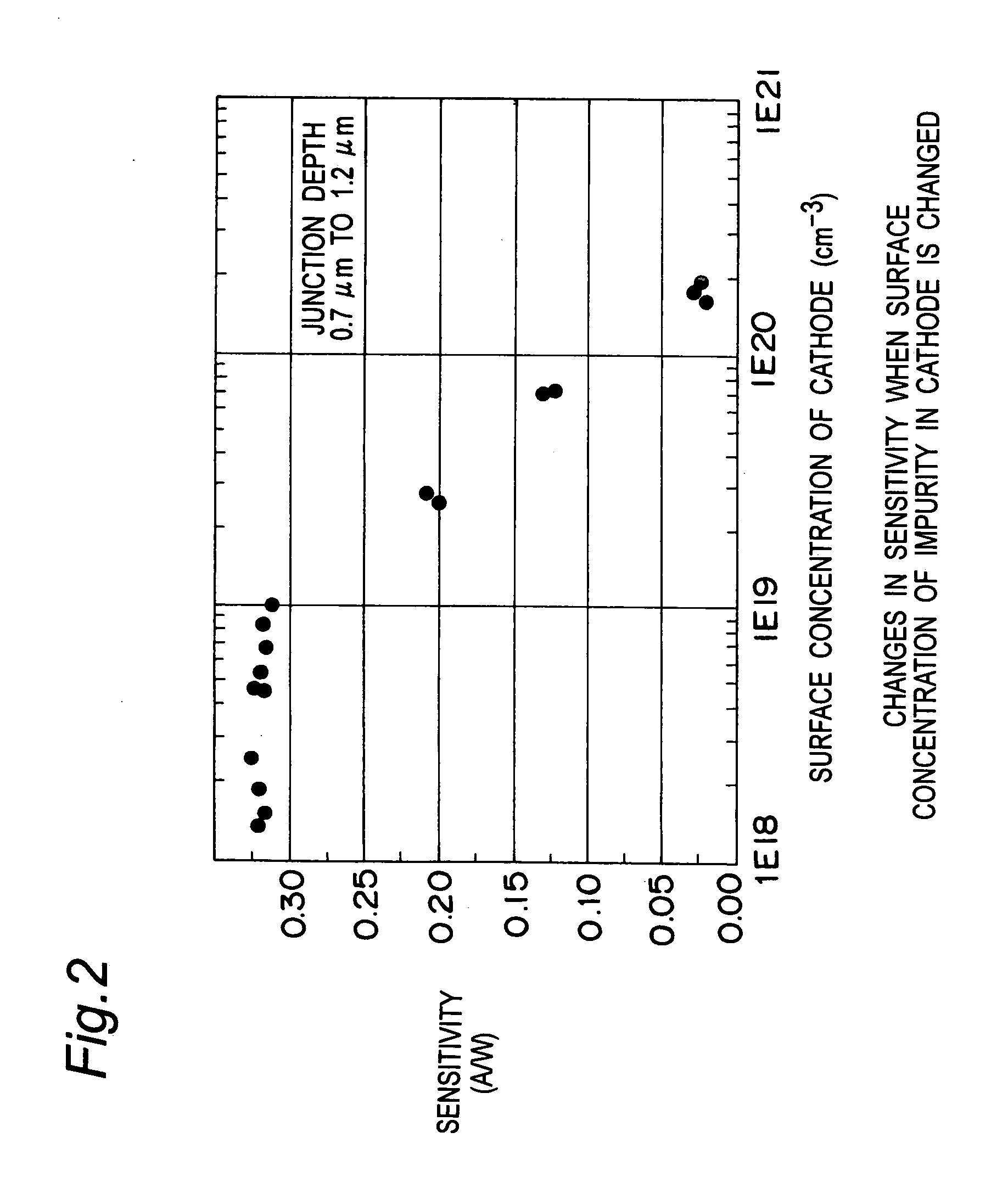Light receiving element and light receiving device incorporating circuit and optical disc drive
a light receiving device and circuit technology, applied in the direction of integrated optical head arrangements, record information storage, instruments, etc., can solve the problems of deterioration of light receiving device sensitivity, increased semiconductor layer, and deterioration of light receiving device response, so as to achieve excellent sensitivity and high response speed
- Summary
- Abstract
- Description
- Claims
- Application Information
AI Technical Summary
Benefits of technology
Problems solved by technology
Method used
Image
Examples
first embodiment
(FIRST EMBODIMENT)
FIG. 1A is a plan view showing a light receiving device in a first embodiment of the present invention, while FIG. 1B is a cross sectional view taken along the line and shown by arrows A-A′ in FIG. 1A. It is noted that in the present embodiment, multilevel interconnections and interlayer films formed after the step for processing metal interconnections are deleted.
As shown in FIG. 1B, the light receiving device has a P type diffusion layer 101 with impurity concentration of about 1E18 cm−3 and a thickness of about 1 μm on a P type silicon substrate 100, and on top surface of the P type diffusion layer 101, has a P type semiconductor layer 102 as a first conductivity type semiconductor layer with impurity concentration of 1E13 cm−3 to 1E15 cm−3 and a thickness of about 10 μm to 20 μm. In the vicinity of the surface of the P type semiconductor layer 102, there is formed an N type diffusion layer (cathode) 103 as a second conductivity type semiconductor layer servin...
second embodiment
(SECOND EMBODIMENT)
FIG. 7 is a graph showing an impurity concentration profile of an N type diffusion layer as a second conductivity type semiconductor layer and a P type semiconductor layer as a first conductivity type semiconductor layer of a light receiving device in the second embodiment of the present invention. The N type diffusion layer forms a light receiving part while the P type semiconductor layer contacts the N type diffusion layer. In the N type diffusion layer that forms the light receiving part, As (arsenic) is used as an impurity. The concentration profile shown in FIG. 7 is formed by detecting the impurity concentration with SIMS (Secondary Ion Mass Spectrometer).
The light receiving device in the second embodiment has the same configuration as the light receiving device in the first embodiment except the point that the impurity of the N type diffusion is As. In this embodiment, description is made with use of the reference numerals identical to those used for the ...
third embodiment
(THIRD EMBODIMENT)
FIG. 10 is a cross sectional view showing a light receiving device in a third embodiment of the present invention. It is noted that in the present embodiment, multilevel interconnections and interlayer films formed after the step for processing metal interconnections are deleted.
The light receiving device of the present embodiment has a P type diffusion layer 201 with impurity concentration of about 1E18 cm−3 and a thickness of about 1 μm formed on a P type silicon substrate 200, and has a P type semiconductor layer 202 as a first conductivity type semiconductor layer with impurity concentration of about 1E13 cm−3 to 1E15 cm−3 and a thickness of about 10 μm to 20 μm formed on the P type diffusion layer 201. Reference numeral 203 is an N type semiconductor layer. Reference numeral 204 is an N type diffusion layer as a second conductivity type semiconductor layer with an impurity diffused for reducing resistance, and the impurity concentration in the vicinity of th...
PUM
| Property | Measurement | Unit |
|---|---|---|
| absorption length | aaaaa | aaaaa |
| thickness | aaaaa | aaaaa |
| conductivity | aaaaa | aaaaa |
Abstract
Description
Claims
Application Information
 Login to View More
Login to View More - R&D
- Intellectual Property
- Life Sciences
- Materials
- Tech Scout
- Unparalleled Data Quality
- Higher Quality Content
- 60% Fewer Hallucinations
Browse by: Latest US Patents, China's latest patents, Technical Efficacy Thesaurus, Application Domain, Technology Topic, Popular Technical Reports.
© 2025 PatSnap. All rights reserved.Legal|Privacy policy|Modern Slavery Act Transparency Statement|Sitemap|About US| Contact US: help@patsnap.com



